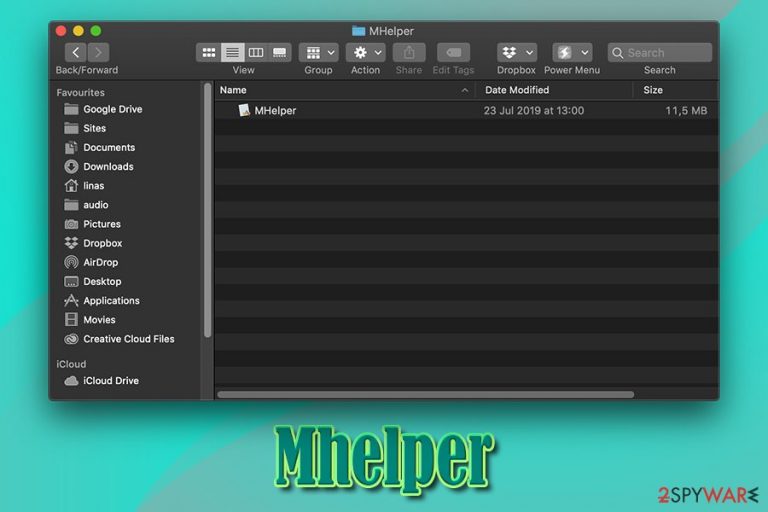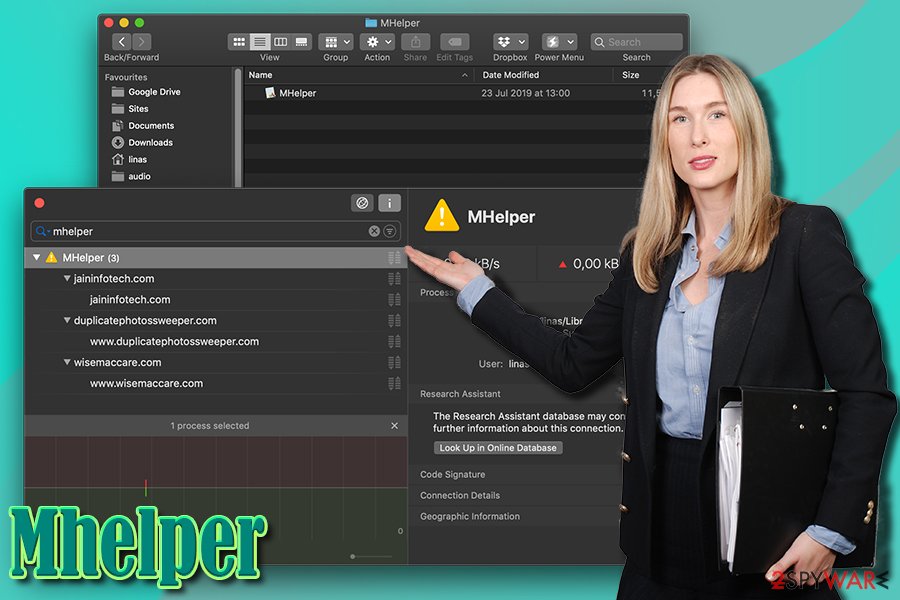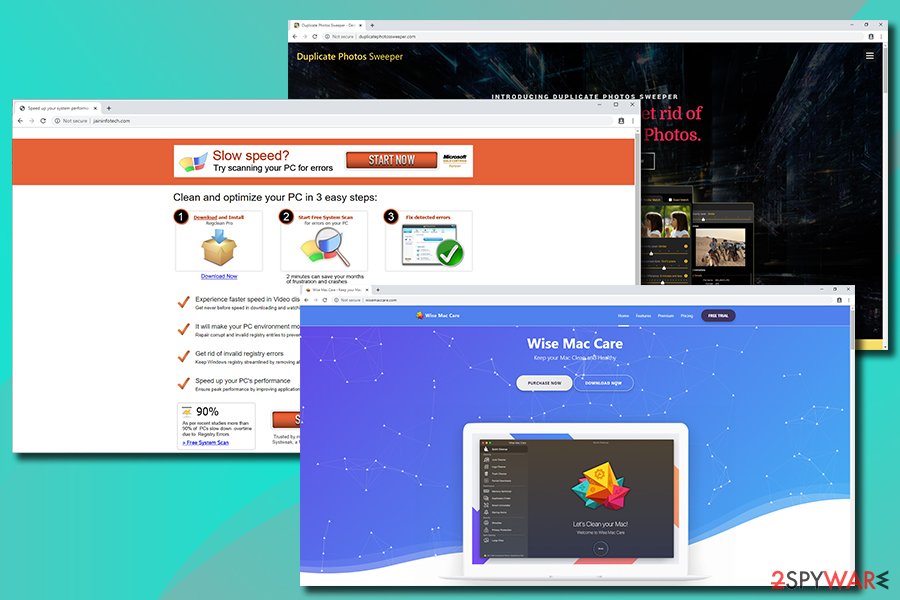Mhelper (Easy Removal Guide) - Free Instructions
Mhelper Removal Guide
What is Mhelper?
Mhelper is a suspicious app that initiates direct downloads of potentially unwanted programs

Mhelper is a Mac application that users may find installed on their computers – it is located in ~/Library/Application Support/MHelper/MHelper.app. Initially, not many will know that the component is installed, and the only symptoms that users experience are occasional redirects to one of the following websites:
- jaininfotech.com
- duplicatephotossweeper.com
- wisemaccare.com
Additionally, the Mhelper virus also starts the automatic download of the promoted applications – Regclean Pro, Duplicate Photos Sweeper, or Wise Mac Care. We highly advise users refrain from installing any of the advertised apps, as they might not only fail to meet the expectations but also damage macOS, as there is no guarantee that the automatically-downloaded .pkg file is what it is promoted to be. Nevertheless, to stop Mhelper redirects and automatic prompts, you will have to terminate it from your computer.
| Name | Mhelper |
| Type | Mac virus, redirect virus, adware |
| Infiltration | In most of the cases, users infect their Macs after installing software from third-party sources. Additionally, adware or malware might be installed on the system after users get tricked by fake Flash updates |
| Associated websites | jaininfotech.com, duplicatephotossweeper.com, wisemaccare.com |
| Symptoms | Users are randomly redirected to sites that promote Regclean Pro, Duplicate Photos Sweeper, or Wise Mac Care. Additionally, the installer file (for example, wisemaccare_rwaff.pkg) is downloaded automatically |
| Termination | Get rid of Mhelper by deleting all the associated components as per the instructions below. Alternatively, you can scan your machine with anti-malware software that detects potentially unwanted apps |
| Recovery & optimization | Instead of relying on scareware applications that claim to speed up and restore your Mac, we advise choosing FortectIntego – this tool can free up space on the system without damaging library files and also get rid of various negative effects that macOS can suffer from after malware infection |
Mhelper adware[1] might appear on the macOS after users install freeware or shareware from third-party sites. Quite often, installers bundle optional components that are just complementary and can be eliminated before being installed. Unfortunately, third-party developers often fail to adequately disclose optional programs and make users install them unintentionally. To avoid such consequences and apps like Mhelper from being installed without your permission, download apps from official sources only.
There are several other remnants of potentially unwanted applications (scareware)[2] like Mhelper that initiate unwanted behavior on macOS systems, including:
- Mhptask
- Maftask
- Helpermcp
- Spchlpr, etc.
All of these apps are the leftovers of potentially unwanted applications like Mac Clean Pro or Similar Photo Cleaner. Apple does not recommend using third-party software that claims to resize, delete or de-clutter photos from macOS library, as it might corrupt the related data. Besides, various fake system optimizers that might actually damage the system instead of fixing it. Thus, if you need reliable application that can remove various threats, and clean up space without damaging library files, download and install FortectIntego.
For Mhelper removal, we recommend deleting all the associated files and also scanning the computer with powerful anti-malware software. The latter is necessary to find out whether more stealthy PUPs or malware is present on the machine.

Beware of software bundling – a distribution technique that allows PUPs to slip in without your direct approval
Software bundling has been successful for years now, simply because users are not keen on paying close attention to downloading and installing new software, despite security experts'[3] warnings. In most cases, they simply click the “Next” button several times until the process is complete. However, this is the biggest mistake users make when installing new programs from third-party sources. Thus, always read through the installation instructions carefully, decline all the optional components, and always opt for Advanced/Custom settings so all the underlying content would be visible. Then, untick all the boxes that would otherwise allow the installer to install PUPs such as adware.
Gatekeeper usually warns users when an unauthorized app is trying to get installed on Mac – users are prompted to enter their passwords in order to proceed. Unfortunately, users sometimes get tricked into installing apps they are not sure about. This is especially common when users are told that they need to update Flash – a plugin riddled with vulnerabilities and soon-to-be-retired by Adobe. The truth is, most users do not need Flash installed in the first place. Additionally, if you are sure you need it, you should always patch it via the automatic updater or access the official website.
Get rid of Mhelper and all its components
Mhelper virus can be installed on Mac for days, if not months before users realize that there is something on their machines that is prompting unwanted redirects to suspicious sites and automatic .pkg downloads. It is yet unknown which application is related to the component, but it is recommended to go through the list of all installed apps and getting rid of everything you do not recognize. Additionally, you should check the following location for a full Mhelper removal:
~/Library/Application Support/MHelper/MHelper.app
You can also remove Mhelper with the help of anti-malware software, which specializes in the detection and termination of potentially unwanted programs or has an option to enable it. By choosing an automatic elimination method, you will also ensure that all other unwanted apps and malware are eliminated from your Mac.

Additionally, we highly advise you reset all of the installed browsers, as adware often changes settings that do do not reset to default after PUP elimination – you can find all the instructions below.
You may remove virus damage with a help of FortectIntego. SpyHunter 5Combo Cleaner and Malwarebytes are recommended to detect potentially unwanted programs and viruses with all their files and registry entries that are related to them.
Getting rid of Mhelper. Follow these steps
Delete from macOS
To get rid of Mhelper and all its components, follow these instructions:
Remove items from Applications folder:
- From the menu bar, select Go > Applications.
- In the Applications folder, look for all related entries.
- Click on the app and drag it to Trash (or right-click and pick Move to Trash)

To fully remove an unwanted app, you need to access Application Support, LaunchAgents, and LaunchDaemons folders and delete relevant files:
- Select Go > Go to Folder.
- Enter /Library/Application Support and click Go or press Enter.
- In the Application Support folder, look for any dubious entries and then delete them.
- Now enter /Library/LaunchAgents and /Library/LaunchDaemons folders the same way and terminate all the related .plist files.

Remove from Mozilla Firefox (FF)
Reset Mozilla Firefox to prevent adware from continuing its activities due to modified settings:
Remove dangerous extensions:
- Open Mozilla Firefox browser and click on the Menu (three horizontal lines at the top-right of the window).
- Select Add-ons.
- In here, select unwanted plugin and click Remove.

Reset the homepage:
- Click three horizontal lines at the top right corner to open the menu.
- Choose Options.
- Under Home options, enter your preferred site that will open every time you newly open the Mozilla Firefox.
Clear cookies and site data:
- Click Menu and pick Settings.
- Go to Privacy & Security section.
- Scroll down to locate Cookies and Site Data.
- Click on Clear Data…
- Select Cookies and Site Data, as well as Cached Web Content and press Clear.

Reset Mozilla Firefox
If clearing the browser as explained above did not help, reset Mozilla Firefox:
- Open Mozilla Firefox browser and click the Menu.
- Go to Help and then choose Troubleshooting Information.

- Under Give Firefox a tune up section, click on Refresh Firefox…
- Once the pop-up shows up, confirm the action by pressing on Refresh Firefox.

Remove from Google Chrome
Delete malicious extensions from Google Chrome:
- Open Google Chrome, click on the Menu (three vertical dots at the top-right corner) and select More tools > Extensions.
- In the newly opened window, you will see all the installed extensions. Uninstall all the suspicious plugins that might be related to the unwanted program by clicking Remove.

Clear cache and web data from Chrome:
- Click on Menu and pick Settings.
- Under Privacy and security, select Clear browsing data.
- Select Browsing history, Cookies and other site data, as well as Cached images and files.
- Click Clear data.

Change your homepage:
- Click menu and choose Settings.
- Look for a suspicious site in the On startup section.
- Click on Open a specific or set of pages and click on three dots to find the Remove option.
Reset Google Chrome:
If the previous methods did not help you, reset Google Chrome to eliminate all the unwanted components:
- Click on Menu and select Settings.
- In the Settings, scroll down and click Advanced.
- Scroll down and locate Reset and clean up section.
- Now click Restore settings to their original defaults.
- Confirm with Reset settings.

Delete from Safari
Remove unwanted extensions from Safari:
- Click Safari > Preferences…
- In the new window, pick Extensions.
- Select the unwanted extension and select Uninstall.

Clear cookies and other website data from Safari:
- Click Safari > Clear History…
- From the drop-down menu under Clear, pick all history.
- Confirm with Clear History.

Reset Safari if the above-mentioned steps did not help you:
- Click Safari > Preferences…
- Go to Advanced tab.
- Tick the Show Develop menu in menu bar.
- From the menu bar, click Develop, and then select Empty Caches.

After uninstalling this potentially unwanted program (PUP) and fixing each of your web browsers, we recommend you to scan your PC system with a reputable anti-spyware. This will help you to get rid of Mhelper registry traces and will also identify related parasites or possible malware infections on your computer. For that you can use our top-rated malware remover: FortectIntego, SpyHunter 5Combo Cleaner or Malwarebytes.
How to prevent from getting adware
Protect your privacy – employ a VPN
There are several ways how to make your online time more private – you can access an incognito tab. However, there is no secret that even in this mode, you are tracked for advertising purposes. There is a way to add an extra layer of protection and create a completely anonymous web browsing practice with the help of Private Internet Access VPN. This software reroutes traffic through different servers, thus leaving your IP address and geolocation in disguise. Besides, it is based on a strict no-log policy, meaning that no data will be recorded, leaked, and available for both first and third parties. The combination of a secure web browser and Private Internet Access VPN will let you browse the Internet without a feeling of being spied or targeted by criminals.
No backups? No problem. Use a data recovery tool
If you wonder how data loss can occur, you should not look any further for answers – human errors, malware attacks, hardware failures, power cuts, natural disasters, or even simple negligence. In some cases, lost files are extremely important, and many straight out panic when such an unfortunate course of events happen. Due to this, you should always ensure that you prepare proper data backups on a regular basis.
If you were caught by surprise and did not have any backups to restore your files from, not everything is lost. Data Recovery Pro is one of the leading file recovery solutions you can find on the market – it is likely to restore even lost emails or data located on an external device.
